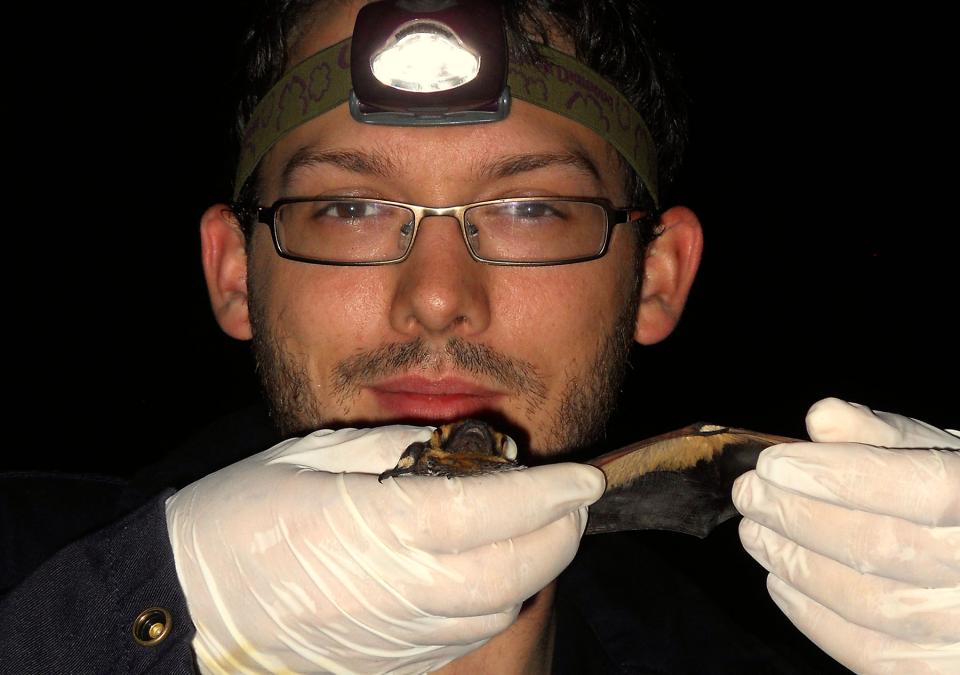
PFW Story
Purdue Fort Wayne’s ‘Batman’ brings spooky science into the light
Especially during the Halloween season, when Scott Bergeson tells people he’s an assistant professor of biology who specializes in bats, he hears all the jokes and myths. People can’t help themselves.
“You just go ‘Uh-huh,’ and laugh a little bit,” Bergeson said. “If they are having fun with bats, it works for me.”
It’s not like he’s going to stop them, but he can correct a few misconceptions, such as:
- We don’t have vampire bats in Indiana because they all live in South America.
- Bats are not blind, though they do have echolocation. “They can see just as well as you and I,” Bergeson said.
- Bats are not rats with wings. Rats only live about two years, while bats can live 35 to 50 years.
- They won’t land in your hair or lay eggs as they give birth. In over 10 years, Bergeson has had only one bat touch his hair. “It was because it was fighting another bat and it was flying around,” he said. “I’ve been in hibernacula (winter quarters like a cave or mine) where they were all flying around, and I turned my light off and not a single one touched me. It was so cool.”
Because he thinks they are so cool, of course, everyone calls Bergeson “The Batman.”
It’s a little understandable why humans have phobias because bats only come out at night and are hard to see – and Disney or Hanna-Barbera never created a cute cartoon character out of a bat.
Bergeson has loved them ever since taking a biology class at Southern Illinois University led by Tim Carter. Bergeson was hooked, later following Carter to Ball State for graduate courses, and found he loved teaching. Bergeson arrived on the Purdue University Fort Wayne campus in 2017.
During the summers, bat females come together to raise their pups. Using radio transmitter tags, Bergeson and students try to figure out where they are roosting so those areas can be protected. He works locally, primarily at Eagle Marsh and Fox Island, and has found a rapidly declining bat population that will likely receive endangered species protection next year.
Bergeson also makes pilgrimages to southern Illinois caves to study hibernating populations, once finding about 65,000 in a mine.
The largest bats found in Indiana have about a 16-inch wingspan with bodies about the length of a finger, Bergeson said. There’s a great deal of diversity among the local population, with potentially hundreds of thousands of bats in the Fort Wayne area, but that’s down 60% for some species over the last 10 years.
The population is declining because of the fungal white-nose syndrome, habitat loss, and wind-turbine mortality. The Little Brown Bat, the most common bat species in North America, has lost 90% of its population and is almost extinct. Mostly that’s due to the white-nose syndrome, a fungal pathogen that grows on their nose and wings during winter hibernation and causes them to starve.
“All of our hibernating bats are dying,” Bergeson said. “We’ve tried to make vaccines, but it’s very hard to catch every single bat. We’ve tried to decontaminate the mines and caves, but there are problems with that because if you kill one fungus you are going to kill all the other native funguses that they need.”
The best option is to make sure there’s enough summer habitat for bats to breed and potentially outlive the syndrome long enough for resistance to evolve. Bergeson and PFW graduate student Deanne Jensen are studying whether insecticides are affecting the bats’ immune systems and making them more susceptible to the disease.
“A lot of things that limit what I can do is the amount of research funding I can find,” Bergeson said. “I would love to go out and figure out what to do to inoculate all these bats, but right now what I can do with my students is work on trying to conserve the bats right here.”
Part of that includes encouraging the use of bat boxes, of which a small one can host 20 bats. Larger ones that can hold up to 50 bats have been placed around the Indianapolis International Airport to make up for dying trees. A rocket box in Eagle Marsh can hold up to 300 bats.
Bats’ main benefit to humans is that they eat their body weight in insects at least once each night.
“If bats weren’t around, the insect population would grow and they would just destroy our ecosystems,” Bergeson said. “Then there’s the economic value in that there are a lot fewer mosquitoes, which are a big vector for disease. There was also a study in 2011 that showed bats save $50 billion each year in insecticides.”
Even to Batman, that’s a lot of money.








